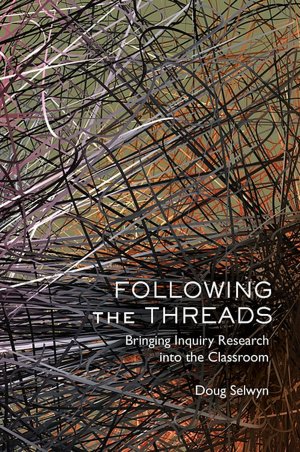 In Following the Threads, former K-12 teacher and current teacher educator Doug Selwyn explores how researchers use inquiry to guide their work. Selwyn interviews artist Roger Shimomura, historian Howard Zinn, classroom teachers, and others to illustrate the power of inquiry to connect learners with the world around them. Although at first glance Following the Threads may look like a research methods book, in reality this well-written and accessible volume is about inquiry as effective pedagogy.
In Following the Threads, former K-12 teacher and current teacher educator Doug Selwyn explores how researchers use inquiry to guide their work. Selwyn interviews artist Roger Shimomura, historian Howard Zinn, classroom teachers, and others to illustrate the power of inquiry to connect learners with the world around them. Although at first glance Following the Threads may look like a research methods book, in reality this well-written and accessible volume is about inquiry as effective pedagogy.
ISBN: 9781433106071 | Peter Lang
About the Author
Doug Selwyn is an associate professor of education at Plattsburgh State University in upstate New York. He taught in Seattle public schools from 1984-2000. He was the Washington State Social Studies Teacher of the Year in 1990-1991, and was a member of the Washington State Council for the Social Studies board. He has written several books on teaching social studies.
Review from Social Science Docket
By Elaine Lawrence
Educators (P-12 teacher, pre-service teacher, teacher educator, or student teaching supervisor) in any content area interested in developing student research skills will find the practices and suggestions laid out in this book extremely useful. These ideas stem from the premise that students need to learn there is more to research than locating information (usually from a list of topics generated by the teacher) and using it to prepare an assignment that is created with a teacher-as-audience focus. As explained by Selwyn, a more real-world approach would be to guide students in the process of figuring out what they want or need to explore to learn more about a topic, which would engage them more in the process. Once this inquisitiveness has students engaged, teachers can help them develop their research skills. The material presented in the book falls within three categories: setting the stage, process development, and examples from K-16 practitioners.
Finding the hook to engage learners is essential to the research process. Students who want to delve beyond who, when, and what to find out why and how will build on their knowledge base. Selwyn offers a variety of approaches for engaging students in historical inquiry. One example is to develop what I call a Mission Impossible scenario — use a topic from local history and give just enough clues to what happened in such a way that students will become curious and want to find out more about the topic. Their mission is to find out more, why they did not already know more about it, and the impact on the present day community. Using the example in the text, teachers would need to be aware of the community reaction so they can adjust the research mission accordingly. Continue reading review (PDF).







Twitter
Google plus
LinkedIn